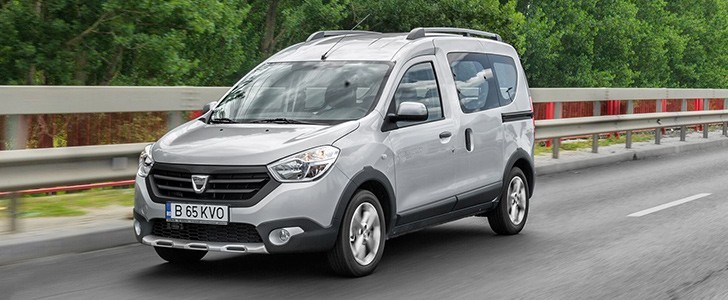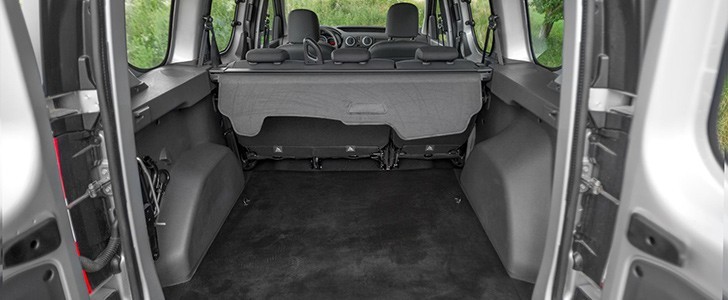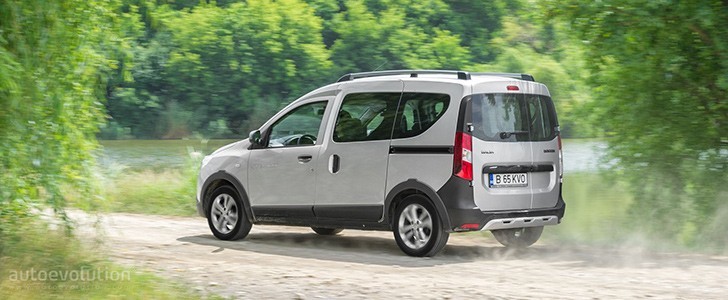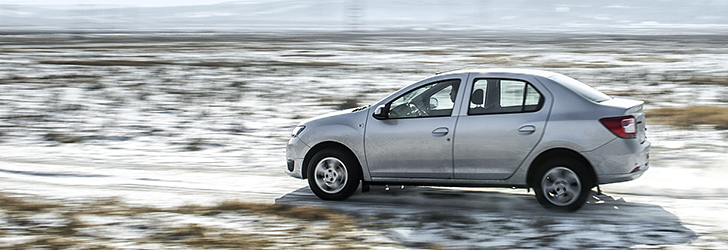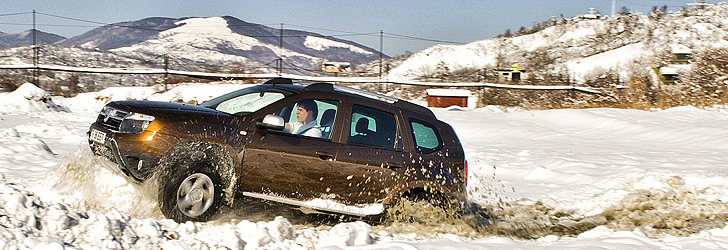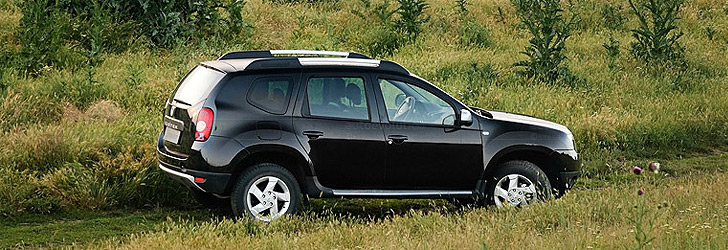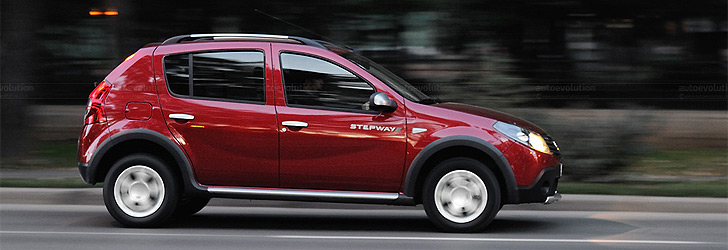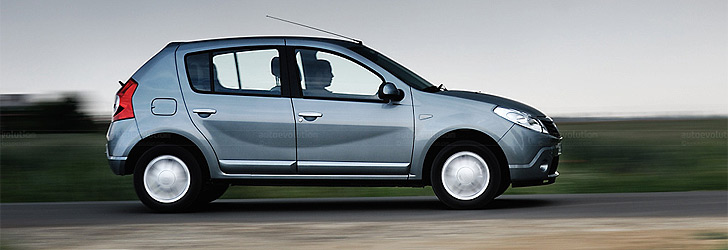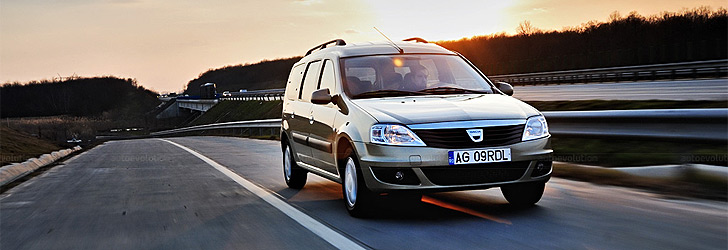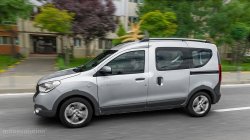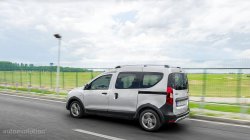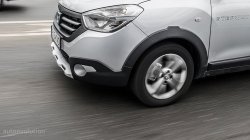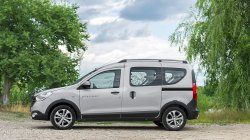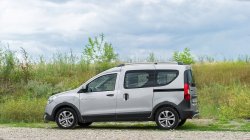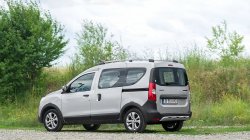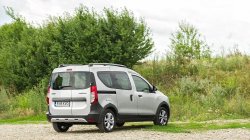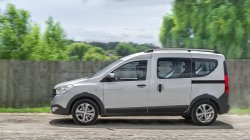2015 Dacia Dokker Stepway Review
OUR TEST CAR: 2015 Dacia Dokker Stepway 1.5 dCi 90
Imagine you are the owner of a small business that sells wholesale flowers, office supplies or provides catering services. You work ridiculously long hours and don't have enough money to buy two cars. So you need just one that can satisfy your business' needs and after work will take you and your family shopping, maybe even on a weekend getaway to celebrate signing that huge contract. Say hello to the 2015 Dacia Dokker Stepway, the go-anywhere van for the hardworking family man.
You can buy a brand new Dokker from just €8,990. In return you get a basic 1.6-liter engine and the sheet metal of an older Renault Kangoo model, disguised as a Dacia. But when you compare it to a new Citroen Berlingo, Fiat Doblo, Mercedes Citan, Opel Combo, Peugeot Partner or Volkswagen Caddy you will discover most of them are twice as expensive.
Think about it: what would you do if you could have bought your current car for half the money? Going back to basics and offering only the essentials has always been the Dacia way of doing things. Models like the Duster and Sandero have brought Renault a huge surge in sales and profits. So will the Dokker do the same in its particular stretch of the woods? Yes, and in many ways it already has. A quick glance at the light commercial vehicle market will reveal some rather ugly designs, most of which appear top-heavy.
All things considered, our Dokker Stepway was quite the looker. Dacia specializes in making cheap cars, so it has mastered the art of hiding the cheapness under slightly oversized features and flat, simple to understand surfaces. Have you ever met a Duster owner who isn't proud of his crossover? Exactly!
Through the Stepway package, the Dokker has inherited many of the characteristics of Dacia's most successful 4x4. It has a slightly chunkier appearance granted by a silver-colored front spoiler and black plastic inserts that surround the car. However, we don't think of this as a different model, more like a trim level that changes some of the design features for the better. You see, all these plastic bits are bolt-ons and the stuff that really matters is the suspension and the amount of equipment offered.
Regular Dokker models have been available since 2012 with several different engines, including a basic naturally aspirated 1.6-liter making 82 hp. However, the Dokker Stepway is designed to be used by families on weekends and, as a result, isn't offered with the cheap stuff. Available from €13,290, the lifted van comes only with the 1.2-liter turbo petrol making 115 hp or the dCi 90 common rail turbodiesel. Both are shared with the Duster and are matched to a 5-speed manual gearbox. The only difference is that the rugged-looking Dokker doesn't come with all-wheel drive.
And that sort of defines the overall experience, since the Stepway package doesn't turn the van into a crossover. The suspension is still that of a cheap box-shaped vehicle designed to carry goods, not a Range Rover. You may sit a little higher off the ground on some resilient new shocks and springs, but the limitations of the twist-beam rear suspension quickly become evident when you go over a bump.
You are probably wondering how the Dokker went from costing just under €9,000 to over €13,000, the same money you would pay for a Skoda Rapid. Well, you should know that the basic models don't come with painted bumpers, a spare wheel, air conditioning or alloy wheels.
The interior of the Dokker quickly reveals where Dacia is cutting corners. After a few hours with the car, we began to understand that buyers are trading all of the quality for the capacity to carry goods. Harsh, scratchy plastics, uncovered metal panels with exposed welding points and old Renault parts from the 2000s set a gloomy mood.
The driving position is typical for a van – you feel like you are sitting on top of the car rather than inside it. Stepway models come with their own interior trim, which included black seats with embroidered backrests and blue stitching. The leather-wrapped steering wheel was a pleasant touch, as were the rubberized pedals. But, we found that the gear stick and the door handle felt cheaper than on a Logan taxi, which isn't saying much.
While we're talking about the shortcomings of the interior, we might also mention the air conditioning system. Its dials felt like the wheels of a toy car, and the recirculation was activated using a switch that belonged on a steam locomotive, not a brand new car. From the driver's perspective, not everything is bad, as Renault has allowed the use of a few decent parts. For example, the toggles for the windows, the indicator stalks and the radio controller behind the steering wheel are all of decent quality. And while the infotainment system was cruder even than the one on a Twingo, it was very simple to use.
Speaking of which, you shouldn't expect too much from the Dokker in the acoustics department. There's very little soundproofing inside the car, and the speakers they used are cheap. To ensure they didn't have to wire the rear doors, they installed speakers behind the passengers in the same area as the parcel shelf. The major redeeming feature of the Dokker's musical side is that pairing any phone is very easy. Let's face it, everybody has a YouTube app on their mobile device these days.
The rear bench of our Dokker Stepway had a 60-40 split. It can also be raised out of the way to create a cavernous loading space. On basic Dokker models, this feature is an optional extra. The cavern created when doing this is so long that you could go camping without a tent. Just fold the bench up and you'll have room to stretch. That's what the people that tested the car before us probably did because we found sand and paw prints on the vinyl cover of the trunk. This feature reminds us of the older Dacia 1300 sedans that were covered in a similar hard, fake leather finish.
In the back, three passengers will sit relatively comfortably. If the driver is taller, knee room will be a problem in the rear, but that’s usually the case with vans of this size. Most of the available space is given to the trunk.
While the official press release doesn't say anything about this, we don't see why the Dacia Dokker Van's maximum payload of 750 kilograms would apply to a Stepway model. With the seats out of the way, a generous load length of 1.9 meters becomes available while about three cubic meters of your belongings can be stored when stacked up to the roof. All you construction workers out there should know that the standard EPAL flat europallet will fit, but only just. To make loading easier, the rear doors can open at 180 degrees. Renault have installed one of their older latch mechanisms that only open at 90 degrees by default so that you don't hit cars on either side by mistake. For the full range of motion, you simply have to pull a couple of latches and voila.
All Dokker models come with plenty of storage spaces on top of the dashboard and under the ceiling. Big bottles also fit inside the doors, but because the cup holders are too big, we spilled coffee quite often onto the sea of black plastic trim. Nobody noticed that when we handed the Dacia in because it is built tough and even has standard rubber trays to keep dirt and water from getting everywhere.
Let's start with the key, which is one the most dated we've seen and dates back to the Nova of the early 2000s. The gearbox is the same 5-speed manual with short ratios as on the Logan, while the 1.5-liter diesel we drove is available on dozens of other cars, including the rival Mercedes Citan Combi and Furgon models.
As crude and unrefined as the engine sound is, we liked the 1.5 dCi. It has the torque needed to pull the van without effort, thanks to 200 Nm (147.5 lb-ft) of torque, 90 percent of which is available from 1,750 rpm. In our urban fuel consumption test cycle, we got 6.4 liters per 100 kilometers (36.7 mpg), which is about 20% more than the official number (5.2 l/100km or 45
mpg). That's not bad at all, considering we had the air conditioning on and didn't try to be fuel sippers.
On the highway, the official number of 4.5 l/100km was off by just one liter. If the Dokker had an extra gear, it would have been even better. Even with only five cogs, if you keep it around the recommended cruising speed of 100 km/h, it should be frugal enough.
On the Stepway model, you can also order a 1.2-liter TCe turbo engine with 115 horsepower and 190 Nm of torque (140 lb-ft). Despite being more powerful, it's also cheaper by €800. However, the fuel bills are going to ruin the ownership experience, so we wouldn’t recommend this engine unless the car is seldom used.
First seen in 2012 under the bonnets of the Megane and Scenic, this is Renault's first engine to benefit from direct injection and turbocharging. However, we've talked to some Megane III owners that say they average about 10 l/100km with this engine around town, so you can imagine what it's like when the brick-like aerodynamics of the Dokker are added to the mix.
So what is this Stepway-branded van like to drive? Well, quite similar to a regular car. The somewhat heavy steering wheel and the precise manual gearbox reward the keen driver. Don't think that you need the arm strength of an axe-wielding Minotaur to turn the wheel.
It's just a little heavier than Renault usually makes its servo systems (it's hydraulic, not electrically assisted). Because of the 7- and 8-speed gearboxes we've grown accustomed to, we were surprised by the short "legs" of the Dokker's 5-speed. You have to move from 1st to 2nd almost immediately and will often find yourself using the last cog around town.
As we've said, the recommended cruising speed is about 100 km/h (62 mph), but we found the Dokker feels stable even at 150 km/h (93 mph), which is near its top speed. The electronic nannies step in way before you can get into trouble, but the slightly taller suspension means the body roll can catch you by surprise. Because of their different end-uses, the specification and calibration of the suspension are specific to different Dokker versions.
Even though the Stepway package makes this van look like a crossover, the Duster is still a better car for "civilian use". The Dokker's MacPhersonfront suspension with triangular arm uses the same layout as all Dacia's other models. The shocks and springs were designed to cope with bad roads, something we had ample opportunity to test when we took a wrong turn and ended on something that resembled a former battlefield. The back end, however, is not deserving of our praise, as the flexible beam with standard springs proved… uncomfortable.
Ground clearance is 200mm across the whole underbody, without those annoying low points some supposed "SUVs" have. You will be able to take most types of road in a stride, and even if you happen to hit one of the bumpers or alloy wheels, they are simply and cheaply replaced.
Because it's a commercial vehicle, the Dokker hasn’t been tested by the specialists at Euro NCAP but its sister, the Lodgy, received a modest 3-star rating that we think applies here as well. While the new Volkswagen Caddy can be ordered with the same safety systems as a Golf, Dacia shows its limited ambitions when it came to protecting its occupants.
In the frontal impact, Euro NCAP noted that the A-pillar of the Lodgy suffered substantial deformation, and the roof was also severely bent, up to the B-pillar. They also noted the fact that the deformation of the body made some interior fittings move towards the occupants, and that the driver’s footwell and transmission tunnel were also noticeably deformed. A crash in one of these and you're not going to be too happy.
The Dacia Dokker Stepway is a flawed car. But when you consider that an equivalently equipped Renault Kangoo costs about €5000 more, and that most rival companies offer nothing below €15,000, everything begins to make sense.
If your business is in dire need of cash, the Dokker is perfect. Its running costs are low, and all the creature comforts can be added to the options list, including heated seats and parking sensors. However, we'd try to spend as little money as possible because this car brand isn't known for excellent residual values.
Think about it: what would you do if you could have bought your current car for half the money? Going back to basics and offering only the essentials has always been the Dacia way of doing things. Models like the Duster and Sandero have brought Renault a huge surge in sales and profits. So will the Dokker do the same in its particular stretch of the woods? Yes, and in many ways it already has. A quick glance at the light commercial vehicle market will reveal some rather ugly designs, most of which appear top-heavy.
All things considered, our Dokker Stepway was quite the looker. Dacia specializes in making cheap cars, so it has mastered the art of hiding the cheapness under slightly oversized features and flat, simple to understand surfaces. Have you ever met a Duster owner who isn't proud of his crossover? Exactly!
Vans like the Dokker are made for carrying goods and people, not winning beauty contests.
Through the Stepway package, the Dokker has inherited many of the characteristics of Dacia's most successful 4x4. It has a slightly chunkier appearance granted by a silver-colored front spoiler and black plastic inserts that surround the car. However, we don't think of this as a different model, more like a trim level that changes some of the design features for the better. You see, all these plastic bits are bolt-ons and the stuff that really matters is the suspension and the amount of equipment offered.
Regular Dokker models have been available since 2012 with several different engines, including a basic naturally aspirated 1.6-liter making 82 hp. However, the Dokker Stepway is designed to be used by families on weekends and, as a result, isn't offered with the cheap stuff. Available from €13,290, the lifted van comes only with the 1.2-liter turbo petrol making 115 hp or the dCi 90 common rail turbodiesel. Both are shared with the Duster and are matched to a 5-speed manual gearbox. The only difference is that the rugged-looking Dokker doesn't come with all-wheel drive.
And that sort of defines the overall experience, since the Stepway package doesn't turn the van into a crossover. The suspension is still that of a cheap box-shaped vehicle designed to carry goods, not a Range Rover. You may sit a little higher off the ground on some resilient new shocks and springs, but the limitations of the twist-beam rear suspension quickly become evident when you go over a bump.
You are probably wondering how the Dokker went from costing just under €9,000 to over €13,000, the same money you would pay for a Skoda Rapid. Well, you should know that the basic models don't come with painted bumpers, a spare wheel, air conditioning or alloy wheels.
The interior of the Dokker quickly reveals where Dacia is cutting corners. After a few hours with the car, we began to understand that buyers are trading all of the quality for the capacity to carry goods. Harsh, scratchy plastics, uncovered metal panels with exposed welding points and old Renault parts from the 2000s set a gloomy mood.
The driving position is typical for a van – you feel like you are sitting on top of the car rather than inside it. Stepway models come with their own interior trim, which included black seats with embroidered backrests and blue stitching. The leather-wrapped steering wheel was a pleasant touch, as were the rubberized pedals. But, we found that the gear stick and the door handle felt cheaper than on a Logan taxi, which isn't saying much.
While we're talking about the shortcomings of the interior, we might also mention the air conditioning system. Its dials felt like the wheels of a toy car, and the recirculation was activated using a switch that belonged on a steam locomotive, not a brand new car. From the driver's perspective, not everything is bad, as Renault has allowed the use of a few decent parts. For example, the toggles for the windows, the indicator stalks and the radio controller behind the steering wheel are all of decent quality. And while the infotainment system was cruder even than the one on a Twingo, it was very simple to use.
Speaking of which, you shouldn't expect too much from the Dokker in the acoustics department. There's very little soundproofing inside the car, and the speakers they used are cheap. To ensure they didn't have to wire the rear doors, they installed speakers behind the passengers in the same area as the parcel shelf. The major redeeming feature of the Dokker's musical side is that pairing any phone is very easy. Let's face it, everybody has a YouTube app on their mobile device these days.
The rear bench of our Dokker Stepway had a 60-40 split. It can also be raised out of the way to create a cavernous loading space. On basic Dokker models, this feature is an optional extra. The cavern created when doing this is so long that you could go camping without a tent. Just fold the bench up and you'll have room to stretch. That's what the people that tested the car before us probably did because we found sand and paw prints on the vinyl cover of the trunk. This feature reminds us of the older Dacia 1300 sedans that were covered in a similar hard, fake leather finish.
In the back, three passengers will sit relatively comfortably. If the driver is taller, knee room will be a problem in the rear, but that’s usually the case with vans of this size. Most of the available space is given to the trunk.
While the official press release doesn't say anything about this, we don't see why the Dacia Dokker Van's maximum payload of 750 kilograms would apply to a Stepway model. With the seats out of the way, a generous load length of 1.9 meters becomes available while about three cubic meters of your belongings can be stored when stacked up to the roof. All you construction workers out there should know that the standard EPAL flat europallet will fit, but only just. To make loading easier, the rear doors can open at 180 degrees. Renault have installed one of their older latch mechanisms that only open at 90 degrees by default so that you don't hit cars on either side by mistake. For the full range of motion, you simply have to pull a couple of latches and voila.
All Dokker models come with plenty of storage spaces on top of the dashboard and under the ceiling. Big bottles also fit inside the doors, but because the cup holders are too big, we spilled coffee quite often onto the sea of black plastic trim. Nobody noticed that when we handed the Dacia in because it is built tough and even has standard rubber trays to keep dirt and water from getting everywhere.
The whole driving experience will feel instantly familiar to every guy who's owned a Dacia over the past decade.
Let's start with the key, which is one the most dated we've seen and dates back to the Nova of the early 2000s. The gearbox is the same 5-speed manual with short ratios as on the Logan, while the 1.5-liter diesel we drove is available on dozens of other cars, including the rival Mercedes Citan Combi and Furgon models.
As crude and unrefined as the engine sound is, we liked the 1.5 dCi. It has the torque needed to pull the van without effort, thanks to 200 Nm (147.5 lb-ft) of torque, 90 percent of which is available from 1,750 rpm. In our urban fuel consumption test cycle, we got 6.4 liters per 100 kilometers (36.7 mpg), which is about 20% more than the official number (5.2 l/100km or 45
mpg). That's not bad at all, considering we had the air conditioning on and didn't try to be fuel sippers.
On the highway, the official number of 4.5 l/100km was off by just one liter. If the Dokker had an extra gear, it would have been even better. Even with only five cogs, if you keep it around the recommended cruising speed of 100 km/h, it should be frugal enough.
On the Stepway model, you can also order a 1.2-liter TCe turbo engine with 115 horsepower and 190 Nm of torque (140 lb-ft). Despite being more powerful, it's also cheaper by €800. However, the fuel bills are going to ruin the ownership experience, so we wouldn’t recommend this engine unless the car is seldom used.
First seen in 2012 under the bonnets of the Megane and Scenic, this is Renault's first engine to benefit from direct injection and turbocharging. However, we've talked to some Megane III owners that say they average about 10 l/100km with this engine around town, so you can imagine what it's like when the brick-like aerodynamics of the Dokker are added to the mix.
So what is this Stepway-branded van like to drive? Well, quite similar to a regular car. The somewhat heavy steering wheel and the precise manual gearbox reward the keen driver. Don't think that you need the arm strength of an axe-wielding Minotaur to turn the wheel.
It's just a little heavier than Renault usually makes its servo systems (it's hydraulic, not electrically assisted). Because of the 7- and 8-speed gearboxes we've grown accustomed to, we were surprised by the short "legs" of the Dokker's 5-speed. You have to move from 1st to 2nd almost immediately and will often find yourself using the last cog around town.
As we've said, the recommended cruising speed is about 100 km/h (62 mph), but we found the Dokker feels stable even at 150 km/h (93 mph), which is near its top speed. The electronic nannies step in way before you can get into trouble, but the slightly taller suspension means the body roll can catch you by surprise. Because of their different end-uses, the specification and calibration of the suspension are specific to different Dokker versions.
Even though the Stepway package makes this van look like a crossover, the Duster is still a better car for "civilian use". The Dokker's MacPhersonfront suspension with triangular arm uses the same layout as all Dacia's other models. The shocks and springs were designed to cope with bad roads, something we had ample opportunity to test when we took a wrong turn and ended on something that resembled a former battlefield. The back end, however, is not deserving of our praise, as the flexible beam with standard springs proved… uncomfortable.
Ground clearance is 200mm across the whole underbody, without those annoying low points some supposed "SUVs" have. You will be able to take most types of road in a stride, and even if you happen to hit one of the bumpers or alloy wheels, they are simply and cheaply replaced.
What's not so great about the Dokker is the crash safety aspect.
Because it's a commercial vehicle, the Dokker hasn’t been tested by the specialists at Euro NCAP but its sister, the Lodgy, received a modest 3-star rating that we think applies here as well. While the new Volkswagen Caddy can be ordered with the same safety systems as a Golf, Dacia shows its limited ambitions when it came to protecting its occupants.
In the frontal impact, Euro NCAP noted that the A-pillar of the Lodgy suffered substantial deformation, and the roof was also severely bent, up to the B-pillar. They also noted the fact that the deformation of the body made some interior fittings move towards the occupants, and that the driver’s footwell and transmission tunnel were also noticeably deformed. A crash in one of these and you're not going to be too happy.
The Dacia Dokker Stepway is a flawed car. But when you consider that an equivalently equipped Renault Kangoo costs about €5000 more, and that most rival companies offer nothing below €15,000, everything begins to make sense.
If your business is in dire need of cash, the Dokker is perfect. Its running costs are low, and all the creature comforts can be added to the options list, including heated seats and parking sensors. However, we'd try to spend as little money as possible because this car brand isn't known for excellent residual values.
Our DACIA Testdrives:
Photo gallery (54)
